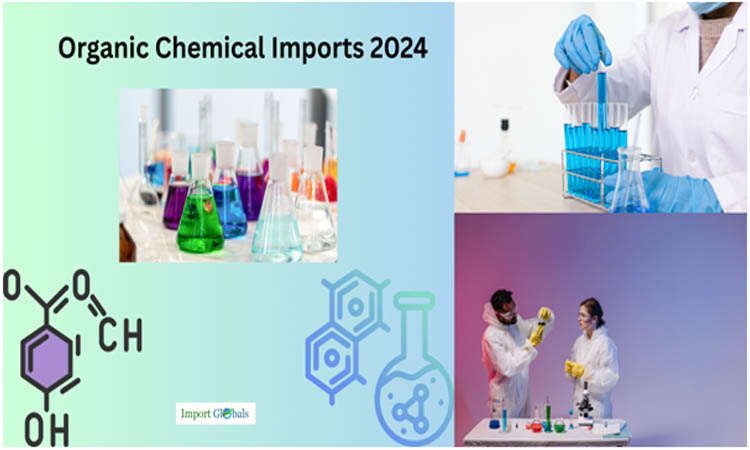
- May 12, 2025
Organic Chemical Imports 2024: A Data-Driven Perspective
Organic chemicals are essential to contemporary industrial operations, ranging from manufacturing and consumer goods to pharmaceuticals and agriculture, per a study on Global Import Export Trade Data on Organic Chemicals conducted by Import Globals. These substances are made up of carbon atoms that are frequently joined to additional elements such as hydrogen, oxygen, nitrogen, and sulfur. They are divided into classes ranging from hydrocarbons to aromatic compounds according to their molecular structure and functional groups.
This blog will go into greater detail about the different kinds of organic chemicals, look at the dynamics of their import and export in 2024, identify the top producers in the sector, and assess the market's growth trajectory.
What Are Organic Chemicals and Why Are They Important?
Compounds that are mostly composed of carbon atoms, together with additional elements like hydrogen, oxygen, nitrogen, sulfur, and more, are referred to as organic chemicals. These substances serve as the foundation for numerous vital sectors, such as manufacturing, petrochemicals, pharmaceuticals, and agriculture. Based on their structures and functional groups, organic compounds can be further classified into several classes.
What Are the Main Types of Organic Chemicals?
Research by Import Globals on Organic compounds Global Import Export Data, they are divided into various classes, each with special qualities and uses. Typical varieties include:
1. Hydrocarbons
Compounds composed solely of hydrogen and carbon are known as hydrocarbons. These are further divided into:
Alkanes are single-bonded saturated hydrocarbons, such as propane, ethane, and methane.
Alkenes are hydrocarbons (such as propene and ethene) that have at least one carbon-carbon double bond.
Alkynes are hydrocarbons (like ethyne) that have at least one carbon-carbon triple bond.
2. Alcohol
A hydroxyl group (-OH) is joined to a carbon atom in alcohols. Typical alcoholic beverages include:
Ethanol is used as fuel, a solvent, and in beverages.
Methanol: An antifreeze and solvent.
3. Aldehydes
A carbonyl group (C=O) is joined to a hydrogen atom and a carbon group in aldehydes. Among the examples are:
Formaldehyde: A disinfectant and resin-making ingredient.
4. Ketones
A carbonyl group (C=O) is joined to two carbon atoms to form ketones. One popular ketone is:
Acetone: A common solvent in the pharmaceutical and cosmetics sectors.
5. Carboxylic Acids
Having a carboxyl group (-COOH), carboxylic acids are frequently utilized in a variety of industries:
Acetic acid is a crucial industrial chemical and a component of vinegar.
6. Esters
When an alcohol and a carboxylic acid combine, esters are created. They are frequently utilized in fragrances and as solvents:
Paints and varnishes frequently contain ethyl acetate.
7. Amines
Nitrogen atoms bound to carbon atoms are found in amines; some examples are as follows:
Pharmaceuticals and herbicides are made with methylamine.
8. Amides
When an amine and a carboxylic acid combine, amides are created. A typical illustration is:
Acetamide: Used in the manufacturing of medications and polymers.
9. Fragrant Substances
Benzene rings or other ring systems with alternating double bonds are found in aromatic compounds. One excellent illustration is:
Benzene: A common ingredient in the manufacture of synthetic fibers, resins, and plastics.
Countries Leading in Organic Chemical Imports for 2024
According to a 2024 IMPORT GLOBALS study on IMPORT EXPORT TRADE DATA in organic chemicals, it is crucial for several sectors, including manufacturing and medicines. The following nations import the most organic chemicals:
The United States
The United States is the biggest importer of organic chemicals worldwide and depends on them for a number of uses, such as consumer goods, agriculture, and pharmaceuticals.
Germany
For its various manufacturing sectors, Germany, a pioneer in industrial production and chemical manufacturing, imports a lot of organic chemicals.
Switzerland
Switzerland, which is well-known for its chemical and pharmaceutical sectors, imports a lot of organic compounds to make high-end chemicals and medications.
India
India's expanding automotive, agricultural, and pharmaceutical sectors are the main reasons it imports organic compounds.
Vietnam
Vietnam imports organic chemicals for its textile and electronics sectors due to its growing manufacturing sector.
The fact that these nations import the most organic chemicals globally shows how dependent they are on these substances to sustain their industrial and economic endeavors.
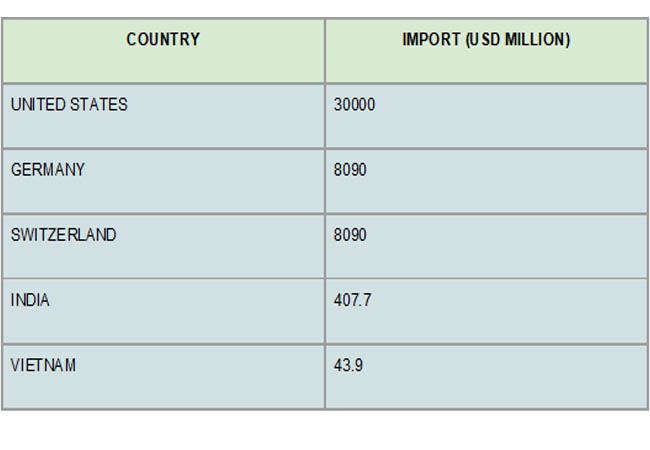
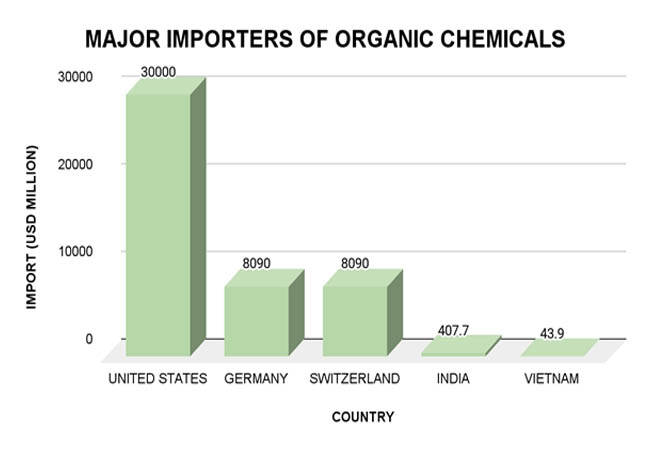
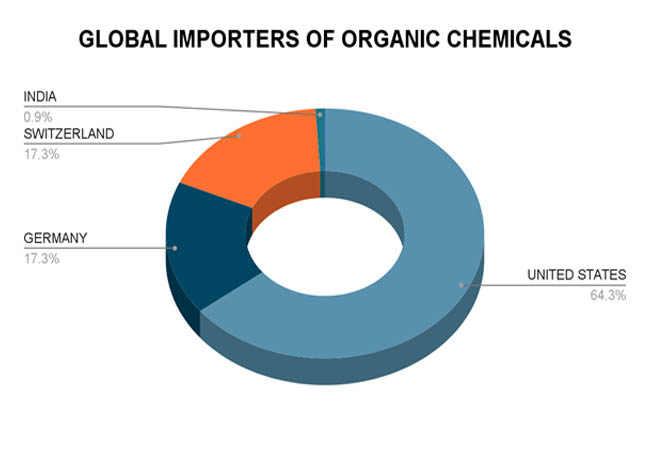
Top Export Nations for Organic Chemicals in 2024
The export of organic chemicals is also essential to the global economy, according to a study by Import Globals on Global Import Export Trade Data of organic chemical compounds. In 2024, the leading exporters of organic compounds are:
China
China is the world's biggest supplier of organic chemicals and is essential to global supply chains, particularly when it comes to the manufacturing of petrochemicals and pharmaceutical intermediates.
US
The United States is also a significant exporter, especially of specialty chemicals used in electronics, industrial processes, and pharmaceuticals.
Ireland
Organic compounds, particularly those utilized in the pharmaceutical sector, are exported in considerable amounts from Ireland.
Switzerland
Switzerland's robust biotechnology and pharmaceutical sectors are the primary drivers of its chemical export value.
Germany
As per the Import Globals Study on Import Trade Analysis, Germany, a renowned chemical producer, sells a wide range of organic compounds to numerous industries worldwide.
These nations support companies that promote innovation and development in a variety of fields, making them essential to the global supply chain for organic chemicals.
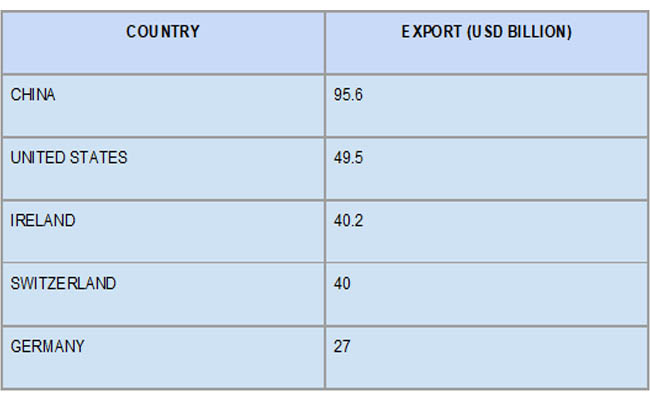
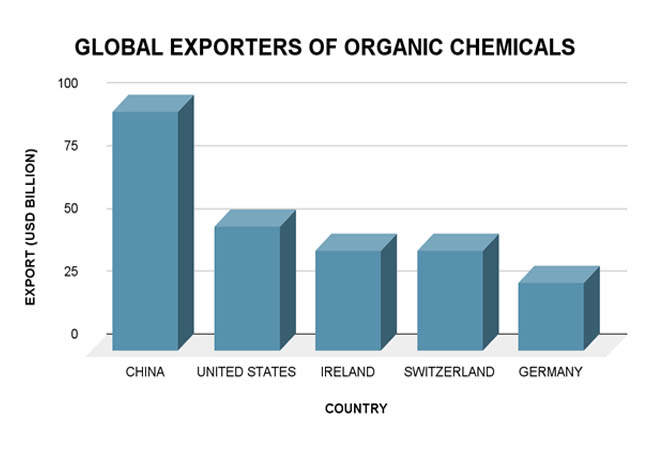
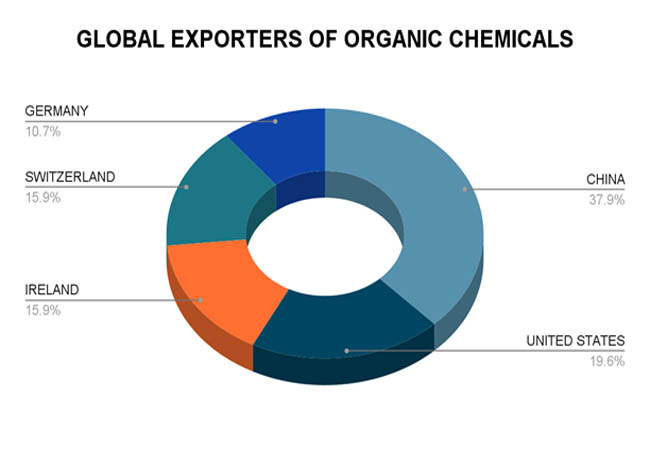
Organic Chemicals: Meet the Industry's Leading Manufacturers
A small number of major producers who provide a broad range of chemicals needed in many industries control the majority of the worldwide organic chemical market, according to Import Globals' Research on the Global Import Export Trade Data. Among the top businesses in this field are:
Germany's BASF
With operations in more than 90 countries, BASF is the world's largest chemical company, creating a wide variety of organic compounds used in consumer goods, automotive, and agricultural products.
Dow Chemical, USA
Dow is a world leader in the manufacturing of specialty chemicals, polymers, and agricultural products.
Saudi Arabia's SABIC
SABIC, a significant petrochemical manufacturer, is well-known for its extensive line of organic chemicals utilized in sectors including electronics, construction, and automobiles.
South Korea, LG Chem
A major force in the petrochemical sector, LG Chem focuses on organic compounds that are utilized in everything from electronics to plastics.
India's Reliance Industries
With goods used in textiles, automobiles, and other industries, Reliance Industries is a prominent petrochemical manufacturer with a significant market share in the global organic chemical market.
The Rising Tide: Organic Chemicals Demand Explained
According to a new report by Import Globals on Global Import Export Data, the burgeoning manufacturing, medicinal, and agricultural sectors are driving the fast growth of the global market for organic chemicals.
? Market Size: The global market for organic chemicals was estimated to be worth $13.89 billion in 2023.
? Forecasted Growth: The market is anticipated to increase at a compound annual growth rate (CAGR) of 7.3% from 2024 to 2032, reaching $26.19 billion.
? The growing need for organic compounds in the production of consumer goods, medications, and agricultural products is a major factor in this increase. This growing market is also a result of the move toward more inventive and ecological chemicals.
Conclusion
Because they are used in so many different industries, organic compounds are an essential part of the global economy. With major countries like the US, China, and Germany playing crucial roles in the import and export of these essential compounds, the market for organic chemicals is expected to continue expanding in 2024. According to the Import Export Trade Data research, the need for organic chemicals is expected to rise further as new technologies and industrial sectors develop, especially in manufacturing, pharmaceuticals, and agriculture.
It is impossible to overestimate the significance of organic compounds in contemporary civilization since they are the basis for innumerable inventions and goods that enhance our day-to-day existence.
If you are looking for detailed and up-to-date Global Import Export Data, You Can Contact Import Globals. Visit www.importglobals.com or email info@importglobals.com for more information.
FAQs
Que. Organic chemicals: What are they?
Ans. Carbon makes up the majority of organic compounds, which also frequently contain hydrogen, oxygen, nitrogen, sulfur, and other elements. They are essential to many sectors, including industry, agriculture, and pharmaceuticals.
Que. In 2024, which nation imports the most organic chemicals?
Ans. The top importers of organic chemicals are the United States, Germany, Switzerland, India, and Vietnam.
Que. What kinds of organic compounds are there?
Ans. Hydrocarbons (alkanes, alkenes, and alkynes), alcohols, aldehydes, ketones, carboxylic acids, esters, amines, amides, and aromatic compounds are examples of organic substances.
